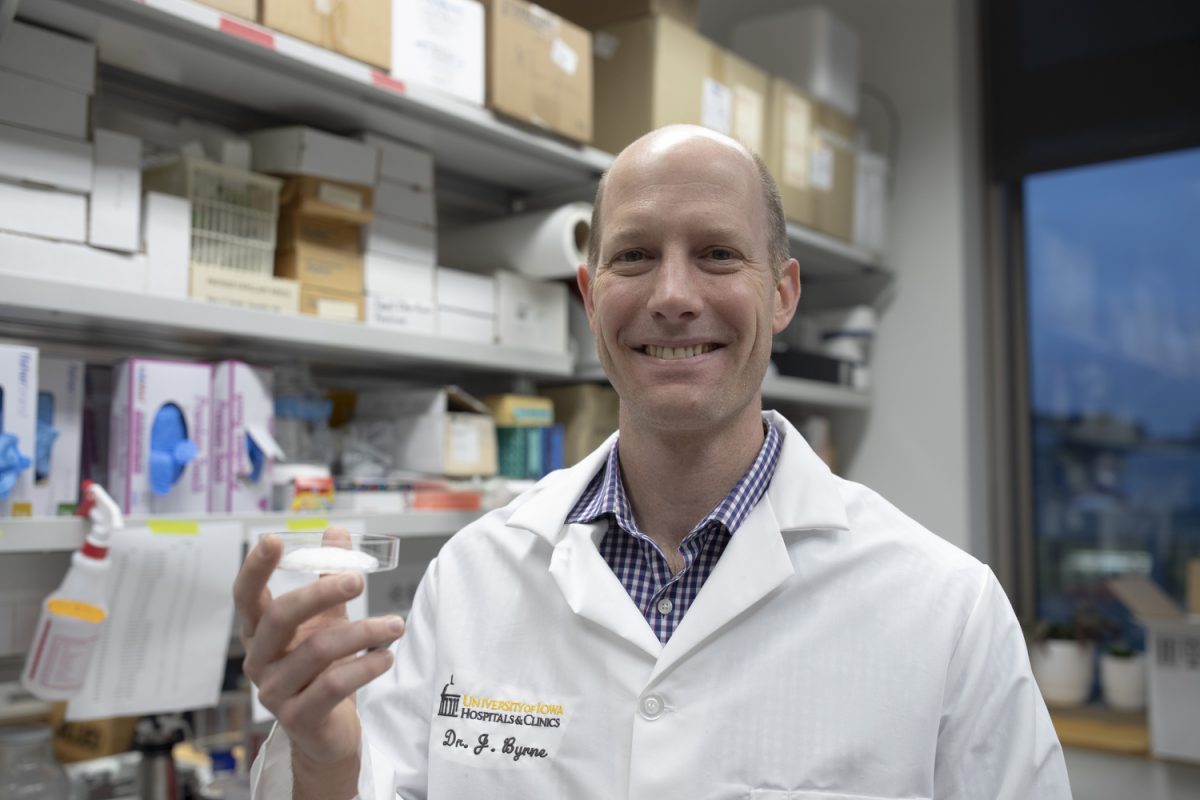A perfectly constructed cappuccino is more than just espresso and milk. The foam that beautifully tops the drink is not just a work of art — it’s a science.
Researchers like James Byrne at the University of Iowa are doing more with the science of foam than baristas are.
Recently, Byrne’s research team received funding to conduct his research in a clinical setting with human patients. The funding, known as the Falk Medical Research Trust Catalyst Award, is designed to provide seed funding to support early-stage research that could lead to new treatments or cures for diseases with limited options.
Byrne, an assistant professor in radiation and oncology at the UI, is working with foams and other substances that he refers to as gas-entrapping materials to increase the amount of oxygen in tumors, allowing them to be more susceptible to cancer treatments like radiation, immunotherapy, and chemotherapy.
“We took a page from the culinary arts, the field of molecular gastronomy, to try and overcome these low oxygen levels in tumors by creating foams in the same way that you’ll find baristas create foams on top of drinks at coffee shops,” Byrne said.
Byrne hopes to begin a clinical trial of oxygen-infused gas-entrapping materials in sarcoma patients in 2025. While the material they are using are already approved by the FDA, they must first get approved an investigational new drug application approved by the FDA before conducting the beginning phases of a clinical trial.
As a postdoctoral student, Byrne started devising unique and alternative ways to deliver gasses into tumors, which transpired in his transition to the UI. He has now actively been doing this research for six years and has made strides in the development of gas-entrapping materials.
“We have some unique systems to try and address the problems of tumor hypoxia or low oxygen levels of tumors, and it’s continued to progress,” Byrne said. “The overall goal is to try and improve the effect of the standard care treatments in cancer.”
The tumors that Byrne and his team are working with are known as malignant peripheral nerve sheath tumors, which are generally treated with radiation and surgery. However, there is a 50 percent chance of the tumor coming back after treatment, Byrne said. With treatments like the gas-entrapping materials, cancer cells will die off more easily and with less harm to other cells in the body.
“Cancer is a huge problem, especially with this type of tumor,” Byrne said. “This specific cancer itself, even though it’s more rare, is extremely aggressive. So, addressing these problems head-on with unique and novel strategies can only help to improve our standard of care therapies.”
In addition to foams, the team is working with materials similar to the candy PopRocks that can trap oxygen inside itself. Byrne has been able to create this medium through collaborations with workers in both the Bay Area and the Quad Cities.
Emily Witt, a research associate in Byrne’s lab, has been working with these materials to create a more enhanced and effective cancer treatment. Her research spans both research in cells and in animal models and will continue as they transfer to the process of human trials.
“There are a variety of different cancers that are affected by tumor hypoxia, and by incorporating oxygen into these different types of tumors, it’s possible to improve on the current care options that are already available to patients and their families,” Witt said.
RELATED: College of Pharmacy dean receives national funding for ovarian cancer research
Witt explained that these treatments have grown in strength and effectiveness over time, becoming more succinct and translatable as options for clinical care for cancer. By developing these transformative technologies, the researchers are improving patient care.
“This is something that is so attainable to incorporate into the technologies that are already used within cancer therapy. We’ve been able to show that adding on to those existing treatments makes them more effective and the tumors more responsive.”
Michael Henry, deputy director for research in the Holden Comprehensive Cancer Center and professor in the Department of Molecular Physiology and Biophysics, has been supporting Byrne’s research as it has been progressing.
“It’s a really new way to think about enhancing cancer therapies as a whole,” Henry said. “In the past, people have focused on using approaches like a hyperbaric chamber to deliver oxygen to tissues. Dr. Byrne has found a way of being able to deliver oxygen and other gases locally to enhance the effect of treatment.”
Henry noted that although Byrne is a young faculty member, he is already making strides in research and advancements to treatments like the gas-entrapping materials. Young faculty members are often the most creatively driven individuals in terms of research, Henry said.
“I’m not aware of any other researchers who are using this approach,” Henry said. “They’re taking principles that are used in food and transforming it to be beneficial in oncology and the medical field, which is really amazing.”



